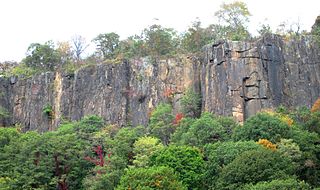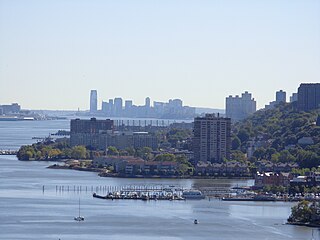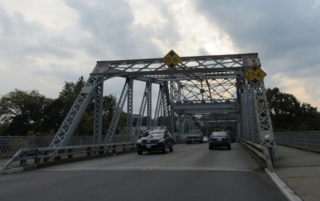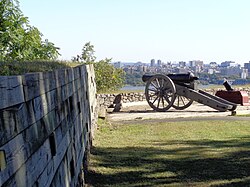
The New York and New Jersey campaign in 1776 and the winter months of 1777 was a series of American Revolutionary War battles for control of the Port of New York and the state of New Jersey, fought between British forces under General Sir William Howe and the Continental Army under General George Washington. Howe was successful in driving Washington out of New York, but overextended his reach into New Jersey, and ended the New York and New Jersey campaign in January 1777 with only a few outposts near New York City under British control. The British held New York Harbor for the rest of the Revolutionary War, using it as a base for expeditions against other targets.

The Palisades, also called the New Jersey Palisades or the Hudson River Palisades, are a line of steep cliffs along the west side of the lower Hudson River in Northeastern New Jersey and Southeastern New York in the United States. The cliffs stretch north from Jersey City about 20 miles (32 km) to near Nyack, New York, and are visible at Haverstraw, New York. They rise nearly vertically from near the edge of the river, and are about 300 feet (90 m) high at Weehawken, increasing gradually to 540 feet (160 m) high near their northern terminus. North of Fort Lee, the Palisades are part of Palisades Interstate Park and are a National Natural Landmark.

The Battle of Pell's Point, also known as the Battle of Pelham, was a skirmish fought between British and American troops during the New York and New Jersey campaign of the American Revolutionary War. The conflict took place in what is now part of Pelham Bay Park in the Bronx, New York City and the villages of Pelham Manor and Pelham in Westchester County, New York.

Palisades, formerly known as Sneden's Landing, is a hamlet in the Town of Orangetown in Rockland County, New York. It is located north of Rockleigh and Alpine, New Jersey; east of Tappan; south of Sparkill; and west of the Hudson River.

George Washington's crossing of the Delaware River, which occurred on the night of December 25–26, 1776 during the American Revolutionary War, was the first move in a complex and surprise military maneuver and attack organized by George Washington, the commander-in-chief of the Continental Army, which culminated in their attack on Hessian forces garrisoned at Trenton. The Hessians were German mercenaries hired by the British.

New Jersey played a central role in the American Revolution both politically and militarily. It was the site of more than 90 military engagements, including the pivotal battles of Trenton, Princeton, and Monmouth. George Washington led his army across the state four times and encamped there during three hard winters, enduring some of the greatest's setbacks of the war as well as seminal victories. New Jersey's decisive role in the conflict earned it the title, "Crossroads of the American Revolution".

New Bridge was a prosperous mill hamlet, centered upon a bridge strategically placed at the narrows of the Hackensack River. In the American Revolution, New Bridge Landing was the site of a strategic bridge crossing the Hackensack River, where General George Washington led his troops in retreat from British forces November 20, 1776. Eleven engagements took place here throughout the war. The current Draw Bridge at New Bridge was installed in 1889 and added to the National Register of Historic Places on July 5, 1989. The area is now a New Jersey historic site in portions of New Milford, River Edge, Hackensack and Teaneck in Bergen County, New Jersey.

The Battle of Fort Washington was fought in New York on November 16, 1776, during the American Revolutionary War between the United States and Great Britain. It was a British victory that gained the surrender of the remnant of the garrison of Fort Washington near the north end of Manhattan. It was one of the worst Patriot defeats of the war.

The Steuben House is a noted example of Bergen Dutch sandstone architecture, located at New Bridge Landing on the Hackensack River in River Edge, in Bergen County, New Jersey, United States.
Paterson Plank Road is a road that runs through Passaic, Bergen and Hudson Counties in northeastern New Jersey. The route, originally laid in the colonial era, connects the city of Paterson and the Hudson River waterfront. It has largely been superseded by Route 3, but in the many towns it passes it has remained an important local thoroughfare, and in some cases been renamed.

The Hudson River Waterfront Walkway, also known as the Hudson River Walkway, is a promenade along the Hudson Waterfront in New Jersey. The ongoing and incomplete project located on Kill van Kull and the western shore of Upper New York Bay and the Hudson River was implemented as part of a New Jersey state-mandated master plan to connect the municipalities from the Bayonne Bridge to the George Washington Bridge with an urban linear park and provide contiguous unhindered access to the water's edge.
Benjamin Blackledge was an American educator and public official. He was the first teacher of English language in Closter, New Jersey, and rose to become "the most prominent man in the northern part of Bergen County". In recognition of his contributions to society, the borough of Closter, in 1998, named a street, Blackledge Court after him.

Burdett's Landing, also called Burdett's Ferry, is a site on the west bank of the Hudson River located in Edgewater, New Jersey. Ferries initially used Burdett's Landing as a departure point for transporting agricultural produce from New Jersey across to New York. In the Revolutionary War it played a role in the movement of American supplies and soldiers, and in the 19th century it served as a landing for steamboats. There is no longer a wharf or ferry service at the landing.
Mollie Sneden born as Mary Dobbs was the operator of a ferry service at Palisades, New York, in the United States, before and after the American Revolution. During the war she was prohibited from running the ferry because of her British sympathies. Mollie Sneden is listed as a Woman of Distinction by the New York Senate.

The Hudson Waterfront is an urban area of northeastern New Jersey along the lower reaches of the Hudson River, the Upper New York Bay and the Kill van Kull. Though the term can specifically mean the shoreline, it is often used to mean the contiguous urban area between the Bayonne Bridge and the George Washington Bridge that is approximately 19 miles (31 km) long. Historically, the region has been known as Bergen Neck, the lower peninsula, and Bergen Hill, lower Hudson Palisades. It has sometimes been called the Gold Coast.

Bulls Ferry is an area along the Hudson River, just north of Weehawken Port Imperial in the towns of West New York, Guttenberg and North Bergen in New Jersey. It takes its name from a pre-Revolutionary settlement belonging to the Bull family, who operated a row-and-sail ferry to the burgeoning city of New York across the river.

The George Washington Bridge Plaza, also known as GWB Plaza or Bridge Plaza, is the convergence of roads and highways around the George Washington Bridge toll plaza in Fort Lee, New Jersey, United States. The plaza is located north of and parallel to Fort Lee's Main Street. The surrounding busy area is characterized by a mix of commercial and residential uses and an architectural variety that includes parking lots, strip malls, houses, gas stations, mid-rise office buildings and high-rise condominiums. Just to the east is Fort Lee Historic Park, Palisades Interstate Park and the bridge's western tower.

The Blackledge–Kearney House is located within the Palisades Interstate Park in the borough of Alpine in Bergen County, New Jersey, United States. The historic stone house was built around 1750 and was documented as Cornwallis Headquarters by the Historic American Buildings Survey (HABS) in 1936. It was added to the National Register of Historic Places on July 24, 1984, for its significance in architecture and exploration/settlement. It was listed as part of the Early Stone Houses of Bergen County Multiple Property Submission (MPS). Lord Cornwallis was believed to have used the house as a temporary headquarters during his crossing of the Hudson River in 1776, but modern historians dispute this claim.

The Fort Lee Museum is a historical museum in Fort Lee, New Jersey on Palisade Avenue within Monument Park. The museum opened in April 1999 and is operated by the Fort Lee Historical Society. The museum closed during the 2020-2022 Covid-pandemic and has not re-opened.

Gregory Avenue Bridge, earlier known as the Main Avenue Bridge, is road bridge over the Passaic River in northeastern New Jersey, United States. It is the 7th bridge to be built at the river crossing. Originally built in 1905 as a moveable bridge, it has been in a fixed closed position since 1985. A four lane road carries traffic between Passaic & Wallington at the Passaic and Bergen county line.


























